

You are using an out of date browser. It may not display this or other websites correctly.
You should upgrade or use an alternative browser.
You should upgrade or use an alternative browser.
dbltree
Super Moderator
What is the difference between the "Groundhog" variety and the regular "oilseed radish"?
Groundhog radishes are an improved tillage variety...developed by Ampac Seed with more info at this link:
GroundHog Radish
GH is a tillage radish...and this pic shows the difference
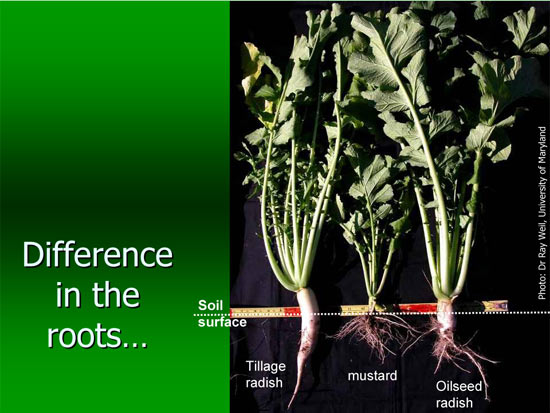
This pic shows the difference in GH versus Daikon radishes
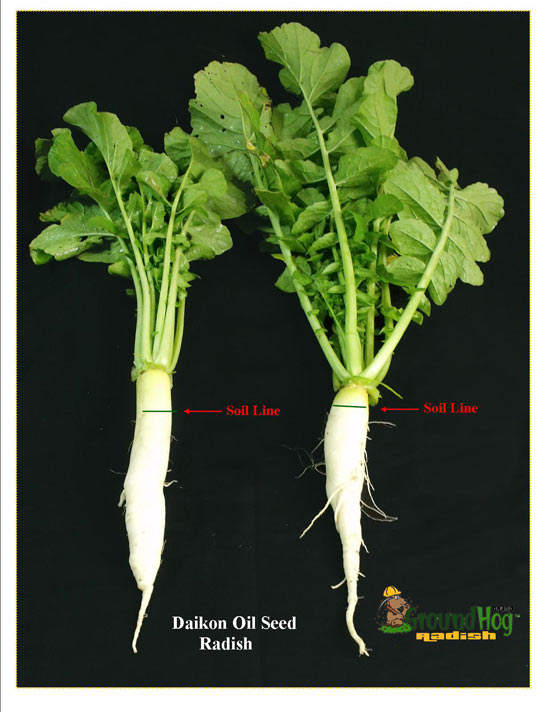
Some folks wonder how deep the GH radish grows?? Note that the tap root can go several feet deeper then the radish itself.

This is one month after planting

Hard to beat for $2.65 a pound from Welter Seed!!
Groundhog radishes are an improved tillage variety...developed by Ampac Seed with more info at this link:
GroundHog Radish
GH is a tillage radish...and this pic shows the difference

This pic shows the difference in GH versus Daikon radishes

Some folks wonder how deep the GH radish grows?? Note that the tap root can go several feet deeper then the radish itself.

This is one month after planting

Hard to beat for $2.65 a pound from Welter Seed!!
dbltree
Super Moderator
This time of year we can evaluate the plots we have planted and determine problems that need to be corrected before the next season but often landowners new to plotting don't really know for sure if they even have a problem.
This picture is of well fertilized healthy brassicas that have not been grazed to use as some base for "normal" healthy non-stressed brassicas...note the healthy green color.

Certainly we hope however that they have indeed been grazed but yet able to sustain some growth as in the case with these brassicas in the next picture.
Heavily grazed but heavily fertilized to promote yields in keeping with grazing pressure so that they do not become unduly stressed.
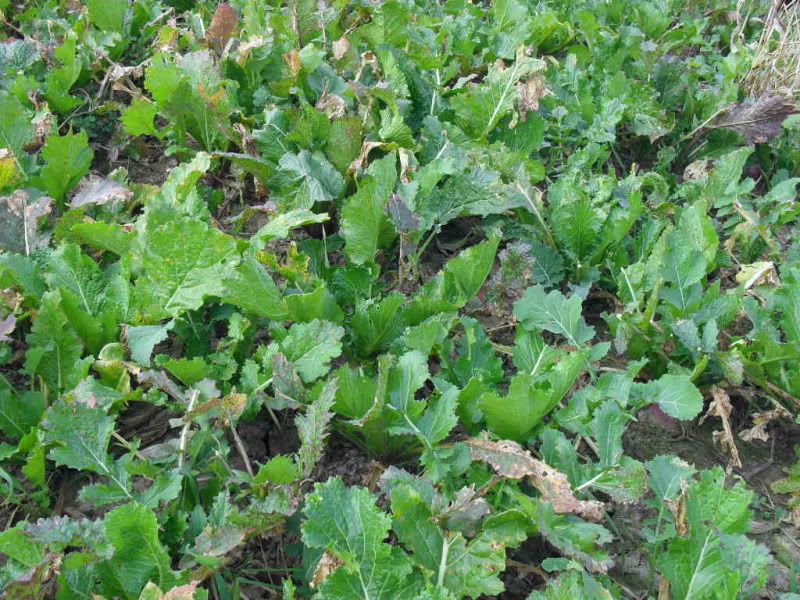
If nutrient levels are high then even grazed plants should have a healthy green color
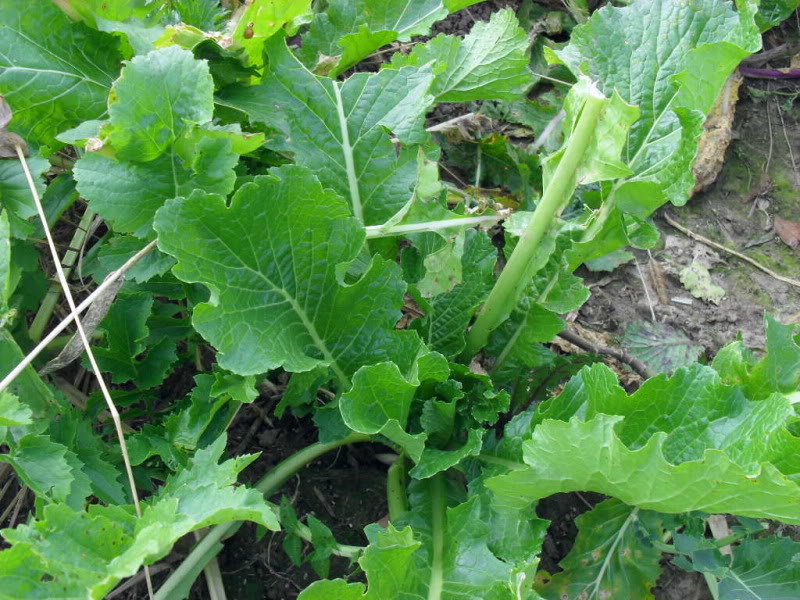
These brassicas have had minimal grazing and were also heavily fertilized so why don't they look like brassicas in the first picture?
Partially because the oats that sprouted "soaked" up a great deal of the nitrogen that was applied and shaded and competed with brassicas, that being the reason I don't advocate mxing cereals or other crops with brassicas.
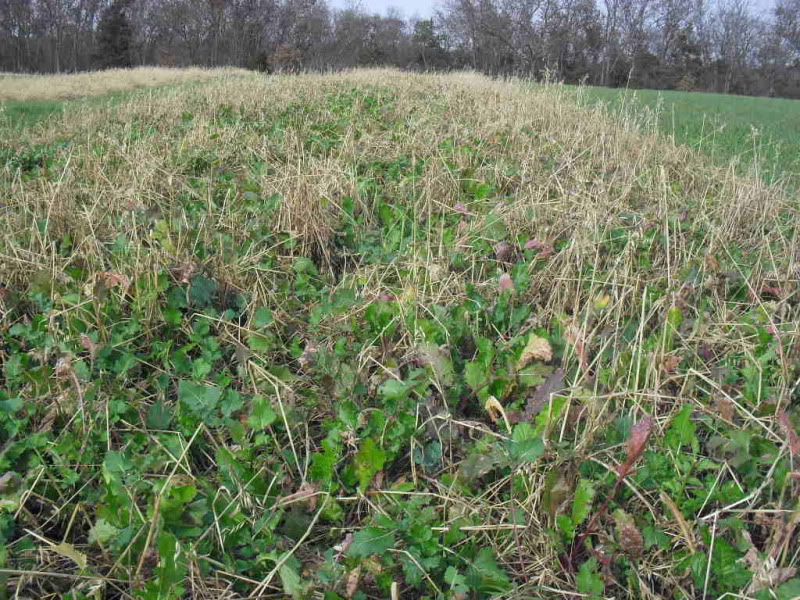
Brassica plants can be stressed from waterlogged soils and drought as they are not fond of either one. Brassicas also crave nitrogen and heavy rains can leach nitrogen beyond root zones, assuming enough was used in the first place.
Always apply 60-90#'s of actual nitrogen at planting when planting brassicas to insure healthy robust growth.
Soil tests will confirm only PH., and P&K levels along with certain micro nutrients if requested but those elements can also be crucial and cannot be ignored...
This picture is of well fertilized healthy brassicas that have not been grazed to use as some base for "normal" healthy non-stressed brassicas...note the healthy green color.

Certainly we hope however that they have indeed been grazed but yet able to sustain some growth as in the case with these brassicas in the next picture.
Heavily grazed but heavily fertilized to promote yields in keeping with grazing pressure so that they do not become unduly stressed.

If nutrient levels are high then even grazed plants should have a healthy green color

These brassicas have had minimal grazing and were also heavily fertilized so why don't they look like brassicas in the first picture?
Partially because the oats that sprouted "soaked" up a great deal of the nitrogen that was applied and shaded and competed with brassicas, that being the reason I don't advocate mxing cereals or other crops with brassicas.

Brassica plants can be stressed from waterlogged soils and drought as they are not fond of either one. Brassicas also crave nitrogen and heavy rains can leach nitrogen beyond root zones, assuming enough was used in the first place.
Always apply 60-90#'s of actual nitrogen at planting when planting brassicas to insure healthy robust growth.
Soil tests will confirm only PH., and P&K levels along with certain micro nutrients if requested but those elements can also be crucial and cannot be ignored...
nannyslayer
New Member
We having a big turnip contest again this year? I've got some that are as big as my hat.
Daver
PMA Member
We having a big turnip contest again this year? I've got some that are as big as my hat.
Maybe so, but I have heard that you have a small head! Let's post
some pictures!
I really meant that as a joke, so please don't take any offense.
dbltree
Super Moderator
Maybe so, but I have heard that you have a small head! Let's post
some pictures!
I really meant that as a joke, so please don't take any offense.
LOL! By all means! Post em up!:way:
nannyslayer
New Member
Maybe so, but I have heard that you have a small head! Let's post
some pictures!

I may have a small head, but I'm talkin about my Mexican sumbrero hat. Yea, their that big. :grin:
whitetail fanatic
Member
dbltree, in an earlier post you stated "You can loosen and improve those "ole clay knobs" by rotating to winter rye/peas/forage radish and red clover every other year and adding any lime or fertilizer the soil is missing." What variety of red clover do you recommend and do you recommend plating it in spring or early August? Does the red clover attract deer in the fall as good as alfalfa? How long does the red clover last, one or two years? Soybeans are supposed to break up the hard soils too, are the groundhog radishes even better for this than soybeans?
thanks
thanks
dbltree
Super Moderator
dbltree, in an earlier post you stated "You can loosen and improve those "ole clay knobs" by rotating to winter rye/peas/forage radish and red clover every other year and adding any lime or fertilizer the soil is missing." What variety of red clover do you recommend and do you recommend plating it in spring or early August? Does the red clover attract deer in the fall as good as alfalfa? How long does the red clover last, one or two years? Soybeans are supposed to break up the hard soils too, are the groundhog radishes even better for this than soybeans?
thanks
I use Alta-Swede Mammoth Red Clover because it is inexpensive and deer hammer the stuff! It's a one cut red clover so it doesn't need a lot of clipping all summer and will last 2-3 years although I plant it to plow down so 1-2 years is about all I let it stand for.
Check this link for more info on the clover itself:
Alta-Swede Mammoth Red Clover
I always include it with my fall planting of winter rye, peas and forage radish, then clip the rye off in late spring. The red clover will go like gangbusters first thing in the spring, right when deer need it most.
The red clover provides a source of high quality protein all summer until I plow it down for my next crop...usually brassicas. The clover will have had roughly 6 months grwing time having been planted in the fall and there for will have fixed 100-150#'s of nitrogen.
Tilling the clover under mill cause it to start decomposing and releasing that nitrogen slowly to the new brassica crop. It's usually not enough to supply ALL the next crops needs but a good share of it.
I find that deer will eat both red clover and alfalfa equally at my place.
Soybeans don't even come plose to a forage radish in breaking up hardpan in fact I wouldn't even consire soys for that purpose. Forage or tillage radishes can send roots down 3-5 feet (tap root) and when the root does, it leaves a tapered hole deep into the subsoil that allows water to penetrate and when it does it also freezes and thaws further breaking up the compacted soils.
The forage radish is like winter rye and will recycle nitrogen and release it as it decomposes the following spring.
It does reqiuire ample nitrogen (as do all brassicas) to send it's roots down thru the hardpan but it will release that N for the next crop.
I have much more detailed pictures and links on this subject in the cereal grain thread that will explain all the attributes of forage radish and why I combine them with winter rye/peas and red clover for an awesome soil building, deer attracting fod plot! :way:
Nontypcl1
Member
Dbltree, What do you typically plant after a brassica crop? I know you have mentioned the allelopathic response of brassicas in that they can inhibit seed germination and growth. Was just wondering if I could go back in and plant something this spring or should I wait and plant it into a fall plot of rye and clover.
This was my first year growing brassicas and they did great until the deer decided they were ready to mow em down in late sept. Once the rye grain and clover was really kickn they gave em a break and let them rebound a little. Now they're back to hammering them again Hopefully they'll leave a few turnips in the ground for late season. This is also the 1st year they haven't stripped the sorghum bare. Looks like they might be leaving it until a good snow or two
Hopefully they'll leave a few turnips in the ground for late season. This is also the 1st year they haven't stripped the sorghum bare. Looks like they might be leaving it until a good snow or two
This was my first year growing brassicas and they did great until the deer decided they were ready to mow em down in late sept. Once the rye grain and clover was really kickn they gave em a break and let them rebound a little. Now they're back to hammering them again
dbltree
Super Moderator
Dbltree, What do you typically plant after a brassica crop? I know you have mentioned the allelopathic response of brassicas in that they can inhibit seed germination and growth. Was just wondering if I could go back in and plant something this spring or should I wait and plant it into a fall plot of rye and clover.
It depends on how much debris is leftover as to the allelopathic chemicals, sometimes you can frost seed clover into the brassica patch but if that doesn't work I usually till it up and either plant oats and berseem clover or buckwheat.
Buckwheat is a safe bet because the seeds are larger and unaffected by the allelopathic chemicals but it also doesn't fix any nitrogen.
The forage radishes also have very strong allelopathic affects so I'm going to try some different tests this year and see what works best but leaving it bare all asome should never be an option.
Always keep the soil growing and working for you!
This was my first year growing brassicas and they did great until the deer decided they were ready to mow em down in late sept. Once the rye grain and clover was really kickn they gave em a break and let them rebound a little. Now they're back to hammering them againHopefully they'll leave a few turnips in the ground for late season. This is also the 1st year they haven't stripped the sorghum bare. Looks like they might be leaving it until a good snow or two
I found the same thing in that my clover and alfalfa along with the rye and pea plots kept them from murdering my brassicas so early. They did severely set them back and root production on those brassicas is very limited.
Planting plots in strips or some type of blocks really helps to keep deer from concentrating on one plant type and also keeps them moving between strips.
This a sample on a friends farm where you can see strips of brassicas with some volunteer oats in them and then strips of winter rye/peas and red clover.

Eventually we'll have a third set of strips that will be white clover and in some cases a 4th strip of milo and/or egyptian wheat.
Some folks make the mistake of mixing them all together in which case they never do well, but planting strips of crops that are compatiable still gives us all the plant species in each plot but not in away that they must compete individually.
The strips make a perfect scenario to allow one to rotate between crops year to year. :way:
whitetail fanatic
Member
"Soybeans don't even come plose to a forage radish in breaking up hardpan in fact I wouldn't even consire soys for that purpose." Maybe what I was thinking was for the top layer of soil. Seems like I had alway heard that soybeans loosen the soil, maybe that's just the surface clods in cloddy fields?
So the radish could be seen as a "poor man's deep tiller", like what they use with the very deep tines to break up the hard pan down deep? Does the forage radish get so big and thick that it will drown out clover like dwarf essex rape would? If you were going to plant forage radish and red clover together, what rate would you plant the radish at? What rate would you recommend for a pure plot of the radish only?
Thanks dbltree.
So the radish could be seen as a "poor man's deep tiller", like what they use with the very deep tines to break up the hard pan down deep? Does the forage radish get so big and thick that it will drown out clover like dwarf essex rape would? If you were going to plant forage radish and red clover together, what rate would you plant the radish at? What rate would you recommend for a pure plot of the radish only?
Thanks dbltree.
dbltree
Super Moderator
"Soybeans don't even come close to a forage radish in breaking up hardpan in fact I wouldn't even consider soys for that purpose."
Maybe what I was thinking was for the top layer of soil. Seems like I had alway heard that soybeans loosen the soil, maybe that's just the surface clods in cloddy fields?
So the radish could be seen as a "poor man's deep tiller", like what they use with the very deep tines to break up the hard pan down deep? Does the forage radish get so big and thick that it will drown out clover like dwarf essex rape would? If you were going to plant forage radish and red clover together, what rate would you plant the radish at? What rate would you recommend for a pure plot of the radish only?
Thanks dbltree.
Yes...tillage radishes will break up hardpan that normally one would need a subsoiler for. The tops could shade out other plants, although they are finer then the big rape or turnip leaves.
Plant forage radish at 10#'s per acre alone but in mixes I plant the following...
September 1st: in this mix the red clover will be tiny and the forage radish will not get as larger nor as thick at 5#'s per acre.
Winter rye 50-80#'s per acre (56#'s = a bushel)
Spring oats 80-120#'s per acre (32#'s = a bushel)
Austrian Winter Peas 20-80#'s per acre (4010 or 6040 field peas will work fine for 1/2 the price)
Red Clover 8-12#'s per acre
Groundhog Forage Radish 5#'s per acre
July 15th: In this mix the forage radish will have time to put down a very long tap root provided it has plenty of nitrogen and competes well with the other brassicas at 5#'s per acre.
Dwarf Essex Rape Seed 1#
Purple Top Turnips 1#
Appin forage turnip 1#
Barkant Forage Turnip 1#
Barnapoli Rape Seed 1/2#
Pasja Hybrid Brassica 1/2#
GroundHog Forage Radish 5#
If you have some really compacted areas, I would plant the Groundhog radish alone at 10#'s per acre and fertilize at 60-90#'s of actual nitrogen and plant them by late July...
Last edited:
dbltree
Super Moderator
I took some soil samples from some plots that are "troubled" to say the least and sent them in for testing. I like using a little weed trowel so I can take a narrow sample without lugging a shovel or some such.
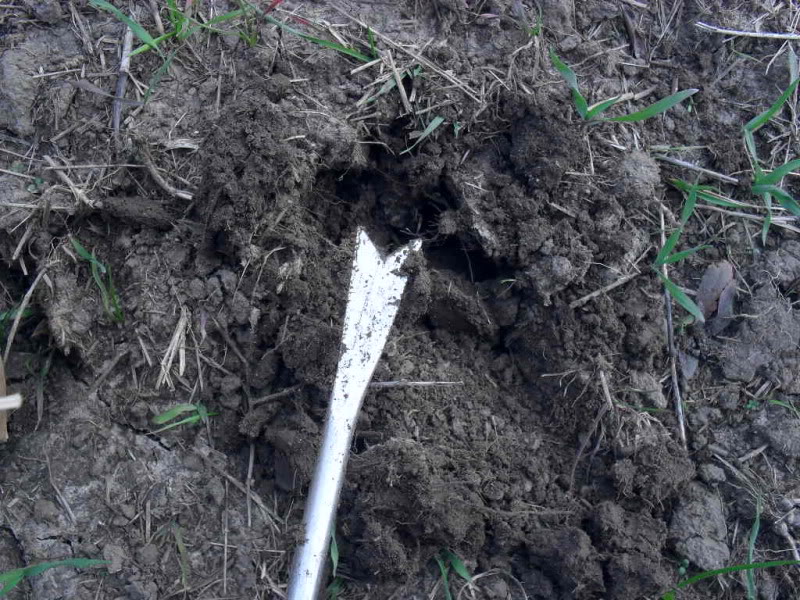
I used soil sample bags that I requested free from the ISU Soil and Plant Lab
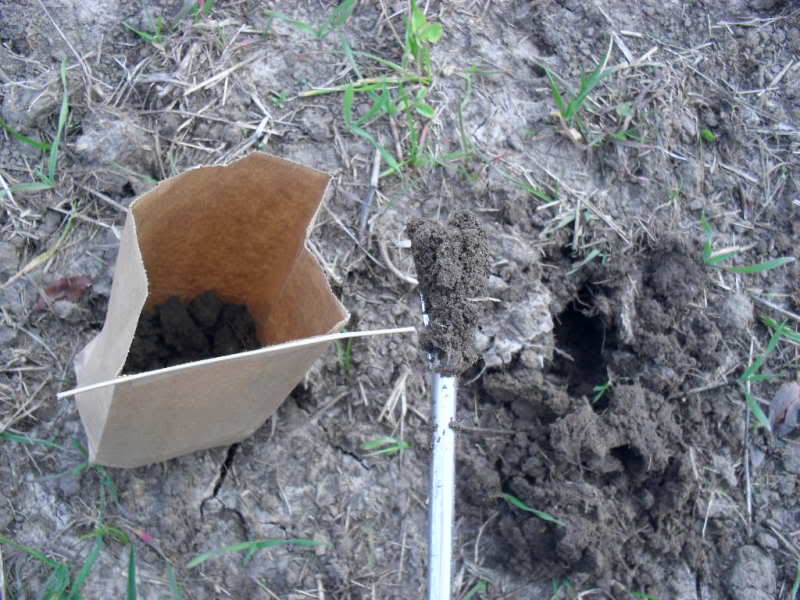
Most states have thier own soil labs and you can contact your local extension agent for more information but I send mine to ISU's soil lab.
This link is to a soil sample information sheet
Soil Sample Info Sheet
ISU Soil Lab home page:
ISU Soil and Plant Analysis Laboratory
$8 a test is a pretty reasonable expense to know what your soil needs and if PH needs to be corrected and gave me some answers as to why this brassica plot did very poorly
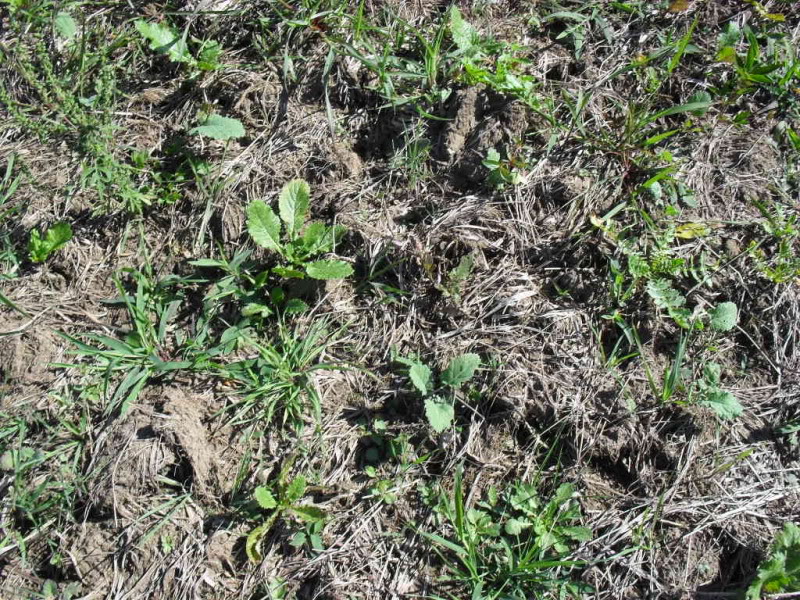
In this case PH was 6.35 but Phosphorus (P) was low and needs 50#'s per acre and 80-90#'s of Potassium (K) plus whatever projected crop removal requires.
P&K levels can be built up so that they can easily be maintained sometimes just by growing the right combination of crops. Both winter rye and forage radish are capable of pulling up potassium from sub soils for instance. They can do this at higher rates the better the soil is and if plenty of nitrogen is available to encourage growth and much of the N can come from previous legume crops.
These are just some very basic links to help you understand more about these elements
Interpret Soil Tests
Understanding Potassium
More about Phosphorus
Understanding Your Soil’s Lime Requirements

I used soil sample bags that I requested free from the ISU Soil and Plant Lab

Most states have thier own soil labs and you can contact your local extension agent for more information but I send mine to ISU's soil lab.
This link is to a soil sample information sheet
Soil Sample Info Sheet
ISU Soil Lab home page:
ISU Soil and Plant Analysis Laboratory
$8 a test is a pretty reasonable expense to know what your soil needs and if PH needs to be corrected and gave me some answers as to why this brassica plot did very poorly

In this case PH was 6.35 but Phosphorus (P) was low and needs 50#'s per acre and 80-90#'s of Potassium (K) plus whatever projected crop removal requires.
P&K levels can be built up so that they can easily be maintained sometimes just by growing the right combination of crops. Both winter rye and forage radish are capable of pulling up potassium from sub soils for instance. They can do this at higher rates the better the soil is and if plenty of nitrogen is available to encourage growth and much of the N can come from previous legume crops.
These are just some very basic links to help you understand more about these elements
Interpret Soil Tests
Understanding Potassium
More about Phosphorus
Understanding Your Soil’s Lime Requirements
dbltree
Super Moderator
These Groundhog tillage radishes continue to amaze me! I planted some in my garden about the second week of September thinking I would share pictures of healthy ungrazed plants. The garden is fenced with a rabbit proof fence but deer can easily hop over it and that's exactly what they did.
Nothing else in the garden but these things and...deer tracks!
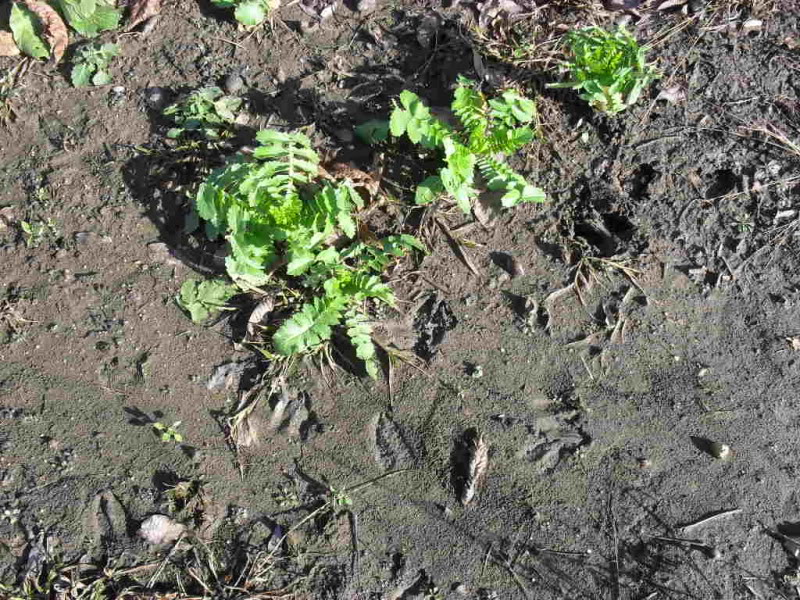
Every plant has been completely or partially eaten
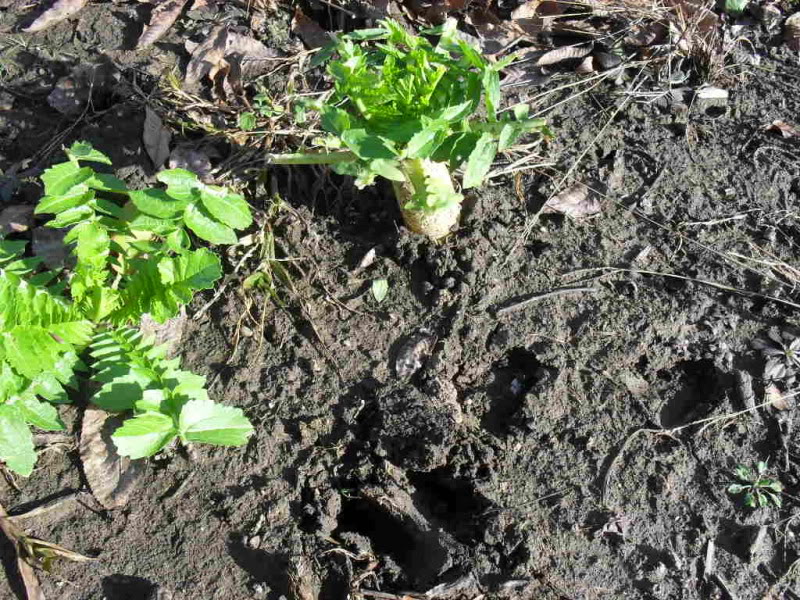
Now one might say "big deal", deer raid gardens and such all the time but for the past three years on my home farm deer have absoutely refused to touch beautiful healthy brassicas...not so much as a nibble, yet they hop over a fence literally feet from my house to eat these forage radishes!
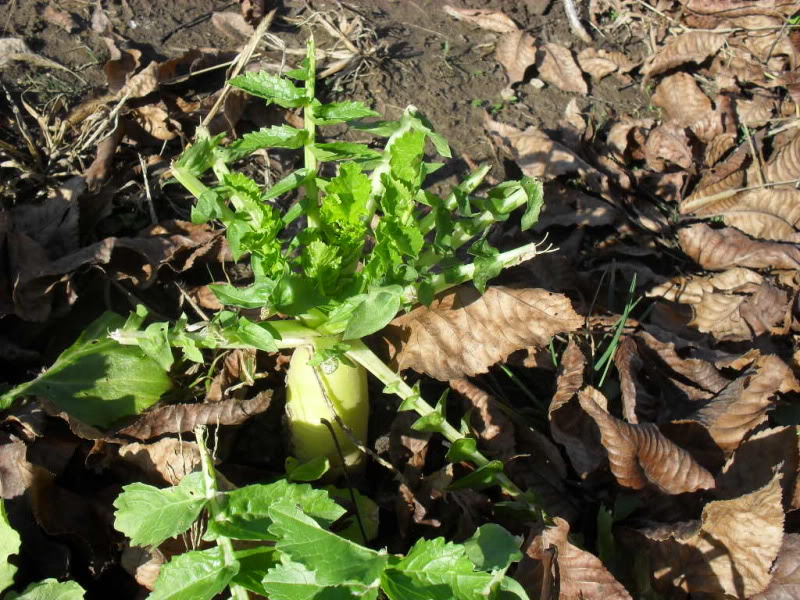
Only a few yards away is a lush alfalfa field where I watch them feed on a daily basis from my kitchen window, so they are certainly not hungry or desperate for feed. They are stopping to feed on these as they return with bellies full so there is no other reason to eat them except because they like them!
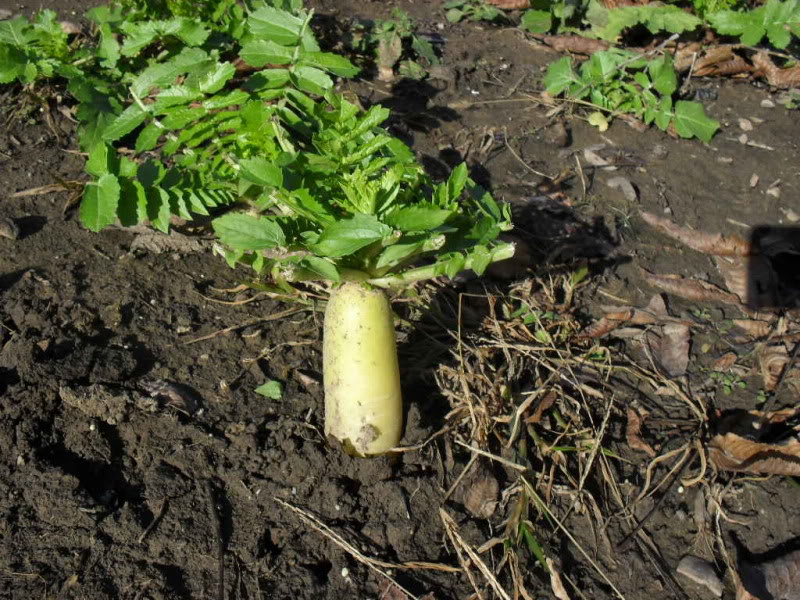
In the meantime the roots are breaking up hardpan and recyling nitrogen so these things are a "win-win" plant!
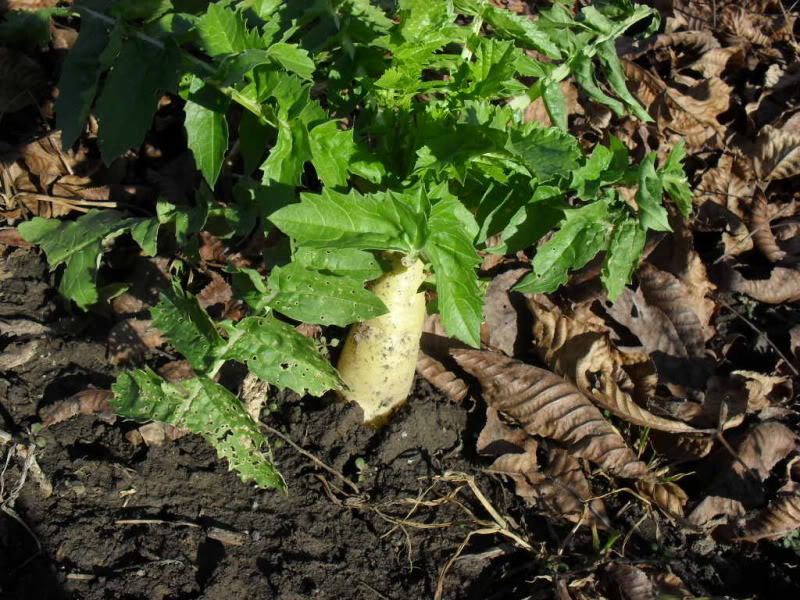
GroundHog Brand radish
ask for them at Welter seed or talk to your local supplier about handling them
Welter Seed
GH radish seed is priced at $2.65 a pound at Welters so compare prices before you order forage/tillage radish seed of any kind...
Nothing else in the garden but these things and...deer tracks!

Every plant has been completely or partially eaten

Now one might say "big deal", deer raid gardens and such all the time but for the past three years on my home farm deer have absoutely refused to touch beautiful healthy brassicas...not so much as a nibble, yet they hop over a fence literally feet from my house to eat these forage radishes!

Only a few yards away is a lush alfalfa field where I watch them feed on a daily basis from my kitchen window, so they are certainly not hungry or desperate for feed. They are stopping to feed on these as they return with bellies full so there is no other reason to eat them except because they like them!

In the meantime the roots are breaking up hardpan and recyling nitrogen so these things are a "win-win" plant!

GroundHog Brand radish
ask for them at Welter seed or talk to your local supplier about handling them
Welter Seed
GH radish seed is priced at $2.65 a pound at Welters so compare prices before you order forage/tillage radish seed of any kind...
So the deer still haven't touched my turnips...I am hoping late season muzzleloader they are eating them. SOOOOOO if they don't eat them I am worried that if I plant them again next yr or the following yr. they still won't eat them. I don't want to waste my time and money planting them again. What makes them all the sudden start eating them if they don't touch them the first yr?
dbltree
Super Moderator
So the deer still haven't touched my turnips...I am hoping late season muzzleloader they are eating them. SOOOOOO if they don't eat them I am worried that if I plant them again next yr or the following yr. they still won't eat them. I don't want to waste my time and money planting them again. What makes them all the sudden start eating them if they don't touch them the first yr?
I hope that brasicas were not the only thing you planted?
Now you see why I plant strips of brassicas, winter rye and peas and clover (not mixed but sepreate strips of each) This allows me to rotate crops each year all within one plot.
It keeps deer moving among food sources, keeps them from wiping out one food source and never allows them to run out of feed.
Deer adapt to brassicas over a few years and I would strongly encourage you to give the Groundhog Radishes a try...they are eating those when they don't touch other brassicas.
If you include other food sources in those plots, they will adapt to them and then eventually start wiping them out....
Here an example of "strip plotting"....

Yeah I only planted brassicas. I thought about that too...I should of put some clover or something different off to one side. Live and learn I guess. I have a dozer sitting behind my house right now getting ready to clear out a timber plot for me. So next yr I will try to mix it up a little different. I still have faith they might start hitting the turnips when the nasty weather hits.
dbltree
Super Moderator
they might start hitting the turnips when the nasty weather hits
I will be suprised if they don't...keep us posted! :way:
Hat Trick
New Member
Finally eating them
I too just planted Brassicas. I mean, they have 40 acres of beans, 8 acres of alfalfa and 6 acres of clover/grass to eat. Starting on the 4th (trail camera evidence) they just absolutely started hammering them. They have eaten nearly half the green browse in the plots in a matter of a few days. They have yet to eat the turnips yet, but I imagine they will eat the crap out of them once they have nothing else to eat.
I have an old friend (70's) that hunts on my place and he has been eating the turnips for weeks from the stand and he said in the last few days they really sweetened up. He picks one on his way in and slices it up. HA HA.
I plan to sit over one of these plots or some standing beans I left. I pray the deer come in droves from all over for a snack!
I too just planted Brassicas. I mean, they have 40 acres of beans, 8 acres of alfalfa and 6 acres of clover/grass to eat. Starting on the 4th (trail camera evidence) they just absolutely started hammering them. They have eaten nearly half the green browse in the plots in a matter of a few days. They have yet to eat the turnips yet, but I imagine they will eat the crap out of them once they have nothing else to eat.
I have an old friend (70's) that hunts on my place and he has been eating the turnips for weeks from the stand and he said in the last few days they really sweetened up. He picks one on his way in and slices it up. HA HA.
I plan to sit over one of these plots or some standing beans I left. I pray the deer come in droves from all over for a snack!